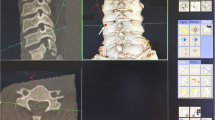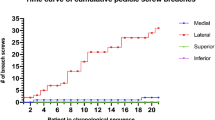Abstract
Objective
For surgical treatment of instable upper cervical injuries, the Harms technique using lateral mass screws provides rigid fixation and favourable clinical outcomes. The use of the posterior arch of C1 as a “pedicle” allows for screw anchorage, giving improved biomechanical stability. Therefore, the aim of this study was to introduce a bilateral safe zone for C1 pedicle screws, regarding screw angulation and pedicle height.
Material and methods
We retrospectively reviewed the CT scans of 500 patients. Three-dimensional reformats were generated for detailed measurements. Centre screw entry point (EP), length of lateral mass as screw trajectory, lateral mass width (LMW), length of screw trajectory (ST), maximal divergence (DI) and maximal convergence (CON) from EP without perforation, and pedicle height (PH) of the posterior arch were measured.
Results
The 500 cases consisted of 335 males and 165 females, with a mean age of 49.5 years. Measurements did not demonstrate significant side-related differences. The mean screw entry point was 22.8 mm from the midline-axis (left 22.6 mm; right 23.0 mm). From this point, a safe zone between 11.6° of divergence and 19.6° of convergence was detected. Measurements of female patients were generally smaller, with significant differences from male patients (p < 0.05). 158 subjects (31.6%) had a PH < 4 mm.
Discussion
C1 pedicle screws were feasible in the majority of patients. Proposing a safe zone for screw angulation may provide safety and avoid screw perforation. However, detailed knowledge of the individual C1 anatomy and the preoperative measurement is essential in the operative planning.




Similar content being viewed by others
References
Matthiessen C, Robinson Y (2015) Epidemiology of atlas fractures–a national registry-based cohort study of 1,537 cases. The Spine J Official J North Am Spine Soc 15:2332–2337. https://doi.org/10.1016/j.spinee.2015.06.052
Malik SA, Murphy M, Connolly P, O’Byrne J (2008) Evaluation of morbidity, mortality and outcome following cervical spine injuries in elderly patients. The Spine J Official J North Am Spine Soc 17:585–591. https://doi.org/10.1007/s00586-008-0603-3
Watanabe M, Sakai D, Yamamoto Y, Sato M, Mochida J (2010) Upper cervical spine injuries: age-specific clinical features. J Orthop Sci 15:485–492. https://doi.org/10.1007/s00776-010-1493-x
Harms J, Melcher RP (2001) Posterior C1–C2 fusion with polyaxial screw and rod fixation. Spine 26:2467–2471. https://doi.org/10.1097/00007632-200111150-00014
Ma XY, Yin QS, Wu ZH, Xia H, Liu JF, Zhong SZ (2005) Anatomic considerations for the pedicle screw placement in the first cervical vertebra. Spine 30:1519–1523. https://doi.org/10.1097/01.brs.0000168546.17788.49
Thomas JA, Tredway T, Fessler RG, Sandhu FA (2010) An alternate method for placement of C-1 screws. J Neurosurg Spine 12:337–341. https://doi.org/10.3171/2009.10.SPINE08541
Resnick DK, Lapsiwala S, Trost GR (2002) Anatomic suitability of the C1–C2 complex for pedicle screw fixation. Spine 27:1494–1498. https://doi.org/10.1097/00007632-200207150-00003
Fensky F, Kueny RA, Sellenschloh K, Puschel K, Morlock MM, Rueger JM, Lehmann W, Huber G, Hansen-Algenstaedt N (2014) Biomechanical advantage of C1 pedicle screws over C1 lateral mass screws: a cadaveric study. The Spine J Official J North Am Spine Soc 23:724–731. https://doi.org/10.1007/s00586-013-3143-4
Zarro CM, Ludwig SC, Hsieh AH, Seal CN, Gelb DE (2013) Biomechanical comparison of the pullout strengths of C1 lateral mass screws and C1 posterior arch screws. The Spine J Official J North Am Spine Soc 13:1892–1896. https://doi.org/10.1016/j.spinee.2013.06.015
Yeom JS, Kafle D, Nguyen NQ, Noh W, Park KW, Chang BS, Lee CK, Riew KD (2012) Routine insertion of the lateral mass screw via the posterior arch for C1 fixation: feasibility and related complications. The Spine J Official J North Am Spine Soc 12:476–483. https://doi.org/10.1016/j.spinee.2012.06.010
Dawes B, Perchyonok Y, Gonzalvo A (2018) Radiological evaluation of C1 pedicle screw anatomic feasibility. J Clin Neurosci 51:18–21. https://doi.org/10.1016/j.jocn.2018.01.006
Srivastava A, Mahajan R, Nanda A, Nanda G, Mishra N, Kanagaraju V, Batra S, Chhabra HS (2017) Morphometric Study of C1 Pedicle and Feasibility Evaluation of C1 Pedicle Screw Placement with a Novel Clinically Relevant Radiological Classification in an Indian Population. Asian Spine J 11:679–685. https://doi.org/10.4184/asj.2017.11.5.679
Ma J, Tang J, Wang D, Zhu Y, Sui T, Cao X (2016) Comparison of perpendicular to the coronal plane versus medial inclination for atlas pedicle screw insertion: an anatomic and radiological study in human cadavers. Int Orthop 40:141–147. https://doi.org/10.1007/s00264-015-2947-8
Pan J, Li L, Qian L, Tan J, Sun G, Li X (2010) C1 lateral mass screw insertion with protection of C1–C2 venous sinus: technical note and review of the literature. Spine 35:E1133-1136. https://doi.org/10.1097/BRS.0b013e3181e215ff
Gunnarsson T, Massicotte EM, Govender PV, Raja Rampersaud Y, Fehlings MG (2007) The use of C1 lateral mass screws in complex cervical spine surgery: indications, techniques, and outcome in a prospective consecutive series of 25 cases. J Spinal Disord Tech 20:308–316. https://doi.org/10.1097/01.bsd.0000211291.21766.4d
Rhee WT, You SH, Kim SK, Lee SY (2008) Troublesome occipital neuralgia developed by c1–c2 harms construct. J Korean Neurosurg Soc 43:111–113. https://doi.org/10.3340/jkns.2008.43.2.111
Yeom JS, Buchowski JM, Kim HJ, Chang BS, Lee CK, Riew KD (2013) Risk of vertebral artery injury: comparison between C1–C2 transarticular and C2 pedicle screws. The Spine J Official J North Am Spine Soc 13:775–785. https://doi.org/10.1016/j.spinee.2013.04.005
AlBayar A, Sullivan PZ, Blue R, Leonard J, Kung DK, Ozturk AK, Chen HI, Schuster JM (2019) Risk of Vertebral Artery Injury and Stroke Following Blunt and Penetrating Cervical Spine Trauma: A Retrospective Review of 729 Patients. World Neurosurg 130:e672–e679. https://doi.org/10.1016/j.wneu.2019.06.187
Huang DG, He SM, Pan JW, Hui H, Hu HM, He BR, Li H, Zhang XF, Hao DJ (2014) Is the 4 mm height of the vertebral artery groove really a limitation of C1 pedicle screw insertion? The Spine J Official J North Am Spine Soc 23:1109–1114. https://doi.org/10.1007/s00586-014-3217-y
Tan M, Wang H, Wang Y, Zhang G, Yi P, Li Z, Wei H, Yang F (2003) Morphometric evaluation of screw fixation in atlas via posterior arch and lateral mass. Spine 28:888–895. https://doi.org/10.1097/01.BRS.0000058719.48596.CC
Xie W, Gao P, Ji L (2017) Three-dimensional spiral CT measurement of atlantal pedicle and its clinical application. Exp Ther Med 14:1467–1474. https://doi.org/10.3892/etm.2017.4710
Zhang L, Wang H (2018) Computed tomographic morphometric analysis of lateral inclination C1 pedicle screw for atlantoaxial instability patients with a narrow C1 posterior arch. Kaohsiung J Med Sci 34:700–704. https://doi.org/10.1016/j.kjms.2018.08.001
Menger RP, Storey CM, Nixon MK, Haydel J, Nanda A, Sin A (2015) Placement of C1 Pedicle Screws Using Minimal Exposure: Radiographic, Clinical, and Literature Validation. Int J Spine Surg 9:43. https://doi.org/10.14444/2043
Tan M, Dong L, Wang W, Tang X, Yi P, Yang F, Hao Q, Zhang G (2015) Clinical application of the “pedicle exposure technique” for atlantoaxial instability patients with a narrow c1 posterior arch. J Spinal Disord Tech 28:25–30. https://doi.org/10.1097/BSD.0000000000000078
Lee BJ, Kim M, Jeong SK, Lee S, Jeon SR, Roh SW, Park JH (2020) Comparison of the Accuracy of C1 Pedicle Screw Fixation Using Fluoroscopy and Free-Hand Techniques in Patients With Posterior Arch Thickness of Less Than 4 mm. Oper Neurosurg (Hagerstown) 19:429–435. https://doi.org/10.1093/ons/opaa067
Mason A, Paulsen R, Babuska JM, Rajpal S, Burneikiene S, Nelson EL, Villavicencio AT (2014) The accuracy of pedicle screw placement using intraoperative image guidance systems. J Neurosurg Spine 20:196–203. https://doi.org/10.3171/2013.11.SPINE13413
Author information
Authors and Affiliations
Corresponding author
Ethics declarations
Conflicts of interest
LP: Research support, Philips Healthcare. The remaining authors declare they have no conflicts of interest.
Additional information
Publisher's Note
Springer Nature remains neutral with regard to jurisdictional claims in published maps and institutional affiliations.
Rights and permissions
About this article
Cite this article
Lenz, M., Harland, A., Egenolf, P. et al. Suggestion of a safe zone for C1 pedicle screws depending on anatomical peculiarities. Eur Spine J 30, 3614–3619 (2021). https://doi.org/10.1007/s00586-021-06993-z
Received:
Revised:
Accepted:
Published:
Issue Date:
DOI: https://doi.org/10.1007/s00586-021-06993-z




